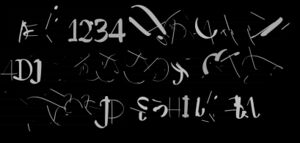Grammatography
grammatography
With the introduction of variable fonts by Adobe, Apple, Google, and Microsoft in September 2016, the stage was set for grammatographic writing, whereby letters are dynamic instead of static. In variable fonts, letter outlines no longer have a static contour, but can be modified by the writer into different shapes according to parameters predefined by the designer. For example, a letter no longer needs to be written in predefined weights such as normal or bold type (as is the case with static fonts), but can now be written in any of the intermediary shapes between normal and bold. Also, dynamic fonts or ‘grammata’ can provide more advanced capabilities whereby letters can be transformed into completely different shapes, defined by the person writing with them. Currently, we can understand this innovation and its potential for transforming cultures of writing only through old concepts and conventions—namely traditional, static-outline fonts and typography. In order to grasp its future potential, we propose a new term: grammatography: writing with prefabricated dynamic letters. These can change their shape during and even after the act of writing.
The term grammatography explicitly contrasts this new method of writing with the ones we are currently using: chirography and typography. When writing by hand, also known as chirography, writers generate the letters themselves while writing text, in contrast to
While Gutenberg was definitely not the first person to use prefabricated letters, he was arguably most influential for the chirographic to typographic transformation of the Western world. Many have written and published about the societal impact of the Gutenberg press, for example Marshall McLuhan, Neil Postman, Vilém Flusser, and Eric A. Havelock. While Flusser is known for his claim that (human) history only started with the act of writing, it is perhaps even more important to recognize to which extent human life is informed by how we write. Up to now, Western modernity has been clearly a typographic one, if only due to the fact that all laws are published in static typographic writing.
But with the introduction of variable fonts, grammatography has become widely available and promises to disrupt this foundational technology undergirding modernity.
There is a clear connection between grammatography and the internet, or more precisely, the technologies that constitute the World Wide Web: the hypertext transfer protocol (http) in conjunction with the hypertext markup language (html) and its extensions CSS and Javascript. This combination of network protocol, file format and, optionally, computer programming language augment linear text into hypertext. However, this technology still only makes the structure of a text dynamic, not the shape of its letters.
In the early days of the internet, most people only understood hypertext as a variation of the static text, and therefore borrowed typographic terminology such as headers, footers, and pages from the foregoing typographic age. Vilém Flusser, however, immediately understood the novelty and consequence of this new technology. When he published a hypertext version of his book Die Schrift in 1987, he wisely and presciently called this publication neither an e-book nor an electronic publication, but simply a ‘nicht mehr Buch’ (‘no longer book’).
Along the same lines, we could ask whether a letter whose shape can be dynamically changed is still a letter, or whether it is rather a no-longer-letter.
Can writing with dynamic letters even be compared with the writing of static letters, or writing by hand?
Grammatography has to do with letters, to the degree that both the writer of the text and the designer of the letters are involved in defining the letter shapes. As such, grammatography could be understood as a new form of writing in addition to our existing forms of writing, an act in which we use new sorts-of-writing instruments, in the same way as we play different musical instruments. The result is an interplay of the performer and instrument builders. Both instruments are characterized by flexible, built-in general vocabularies that are subsequently performed; in music, musical scales like the chromatic scale, in text, script likes Latin script.
Grammatography can open up as many possibilities for writing as musical instruments can for making sound. While we primarily play musical instruments for aesthetic reasons (expressions of feelings instead of communicating precise messages), a similar expressive range could (re)emerge in this new kind of writing. Grammatography points to a form of writing that transcends the currently dominant typographic logic of writing, and frees the act of writing from its typographic imprisonment.
A historical note: the term grammatography was first used in 1605, in a publication in which the Dutch calligrapher Cornelis Dirckszoon Boissens demonstrated his penmanship. Its full title is Grammato-Graphices. In Quo Varia Scripturae Emblemata (‘Grammato-Graphices. Containing Various Illustrations of Handwriting’). In 1861, grammatography was also used in the English translation of the German publication Alphabete orientalischer und occidentalischer Sprachen: Grammatography: a Manual of Reference to the Alphabets of Ancient and Modern Languages. Why the translator chose this term is unknown. Finally, the word grammatography appears in De la grammatologie (1967) by Jacques Derrida. Here, the term is used as a synonym for calligraphy. Finally in 2019, the Dutch type foundry Underware proposed to use this term for every kind of writing that involves dynamic letters. This proposal was made in response to the technical invention of variable fonts.

